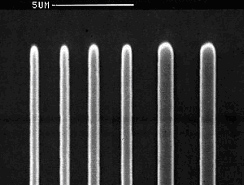|
The LaserWriter pattern generator Planar
laser lithography and direct writing |
|
|
The LaserWriter system by MICROTECH is designed for the definition of
planar geometries and for surface diagnostics, in applications where maximum
resolutions down to 0.7 µm are required. The system transforms a laser beam
into a controlled writing tool for photolithographic mask fabrication or for
direct in situ processing on planar substrates. Besides
microlithographic applications, its optical apparatus and substrate motion
management are also well suited for surface inspection or diagnostics. Hence,
the same machine can be used first for producing a pattern and later for
inspecting the results. The patterns are generated by accurately moving the
target (mask or substrate) underneath a focused and scanning laser beam with
proper wavelength. The performance and cost of the system are optimised for
research and development or small/medium productions. Application fields Pattern generator LW405 specifications Picture gallery |
|
|
Application fields of the LaserWriter Microelectronics Integrated Optics Diffractive Optics Micromechanics Microcryogenics Hybrid circuits Flat panel displays Microwave Integrated Circuits (MICs) MultiChip Modules (MCM) Photovoltaics Photoelectrochemistry For
each application the proper LaserWriter configuration can be selected and
customised. |
|
|
The
in house availability of a LaserWriter system for microlithography
means: - cutting
down mask costs when developing new prototypes; - minimal
mask making times (masks are available just a few minutes after
patterning ends);
- possible
elimination of masks and mask aligner. For single or low quantity
prototypes it can be convenient to draw directly on the final substrate. This
possibility is also profitable when a clean room suitable for the use of a
mask aligner/exposer is not available: direct writing results in reduced
substrate handling, that is a reduction of microcontamination induced
defects. |
|
|
A GENERAL PURPOSE MICROTOOL Depending
on customer needs, the LASER WRITER system can also be configured as a
research or production tool for surface microprocessing, such as:
|
|
|
AN INSPECTION AND DIAGNOSTIC TOOL Both
laser and non laser applications can be developed for:
|
|
When
you need a discretionary 2-D process, why spend time with electronics,
mechanics, optics, high and low level programming, electrooptics? Concentrate
your efforts on the process, minimize development time and let MICROTECH take
care of the hardware. Is it expensive to buy and maintain? Major
characteristics of the LaserWriter are competitive price and reliability.
These are obtained by customizing the system and by carefully selecting and
sizing all its components, for years of maintenance-free use. Among
competitors' systems with similar performances, the LaserWriter is by far the
lowest priced. Note that commercially available systems from other
manufacturers are mostly oriented to high-volume microelectronic production. Therefore,
their performances - and prices as well! - match such target market. The
LaserWriter is designed and optimised for research and development
applications and for small/medium productions. Hence, while keeping the
precision patterning features available in alrger and much more research
centres or small/medium manufacturers. The
maintenance costs of the LaserWriter are also very low. The system is
designed to require virtually null maintenance over several years of use. Of
course, the natural aging of the laser source is unavoidable, but the refurbishment
timecan be easily predicted and laser replacement is typically a matter of
minutes. Which system configuration should be selected? One basic
LaserWriter model is available for microlithographic applications, with some
options. Such model is just the starting point for customisation. Its main
features are detailed in the specifications table. Note
our commercial approach as follows. When dealing with MICROTECH, the client
can choose between two procedures:
Each
system is driven by LaserDraw-2D, a MICROTECH proprietary software
package. Details
of typical patterns are reported in the 2-D
lithography picture gallery page. Are
you concerned for the limited floor space available? Place the
LaserWriter everywhere in your clean-room. The footprint of the latest
release of the system is just 65x65 cm, including drive electronics! Are
you concerned for system servicing? The hardware and software
modular design of the LaserWriter minimizes system downtime and makes
servicing or upgrading simple and quick. |
|




